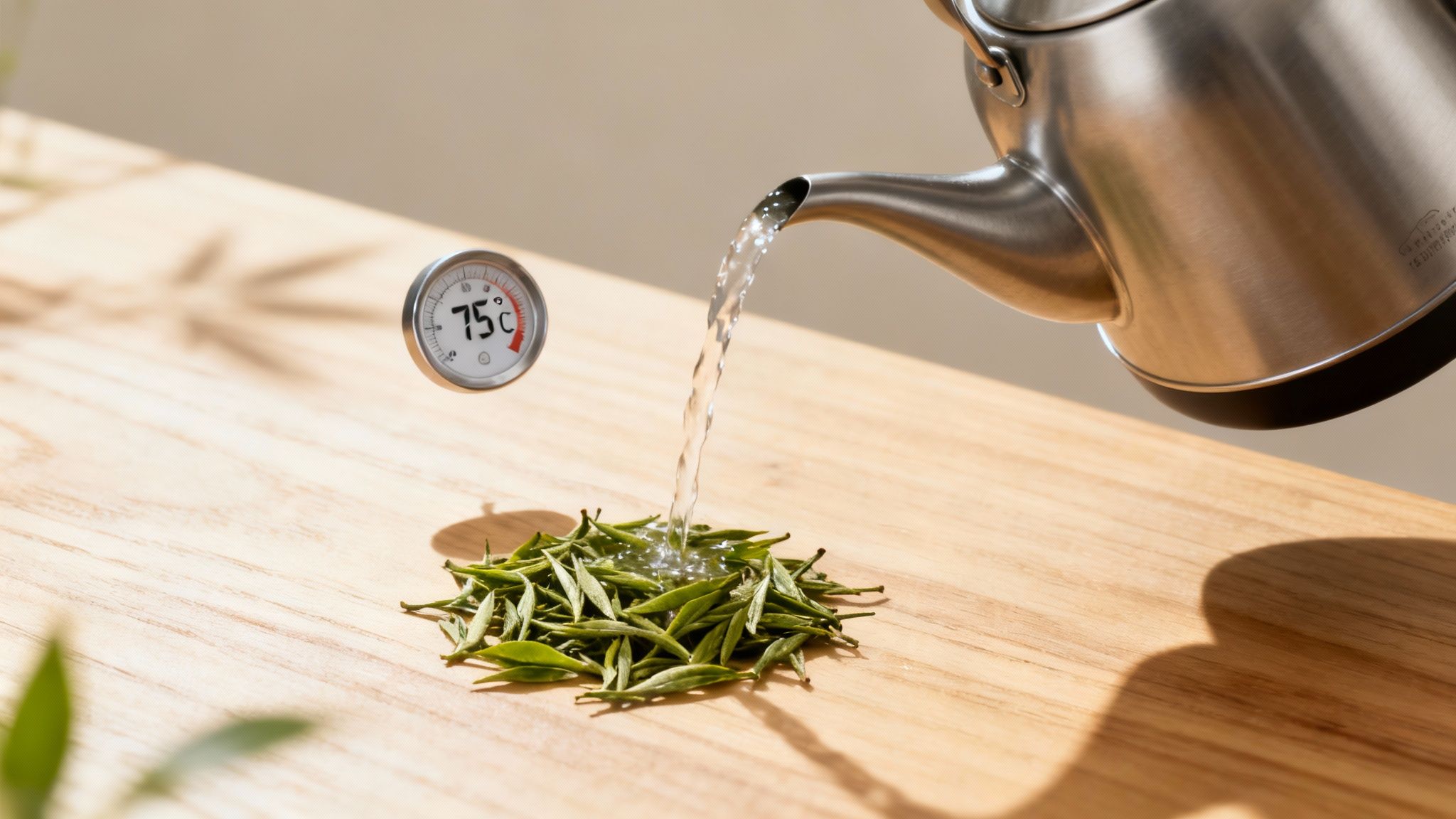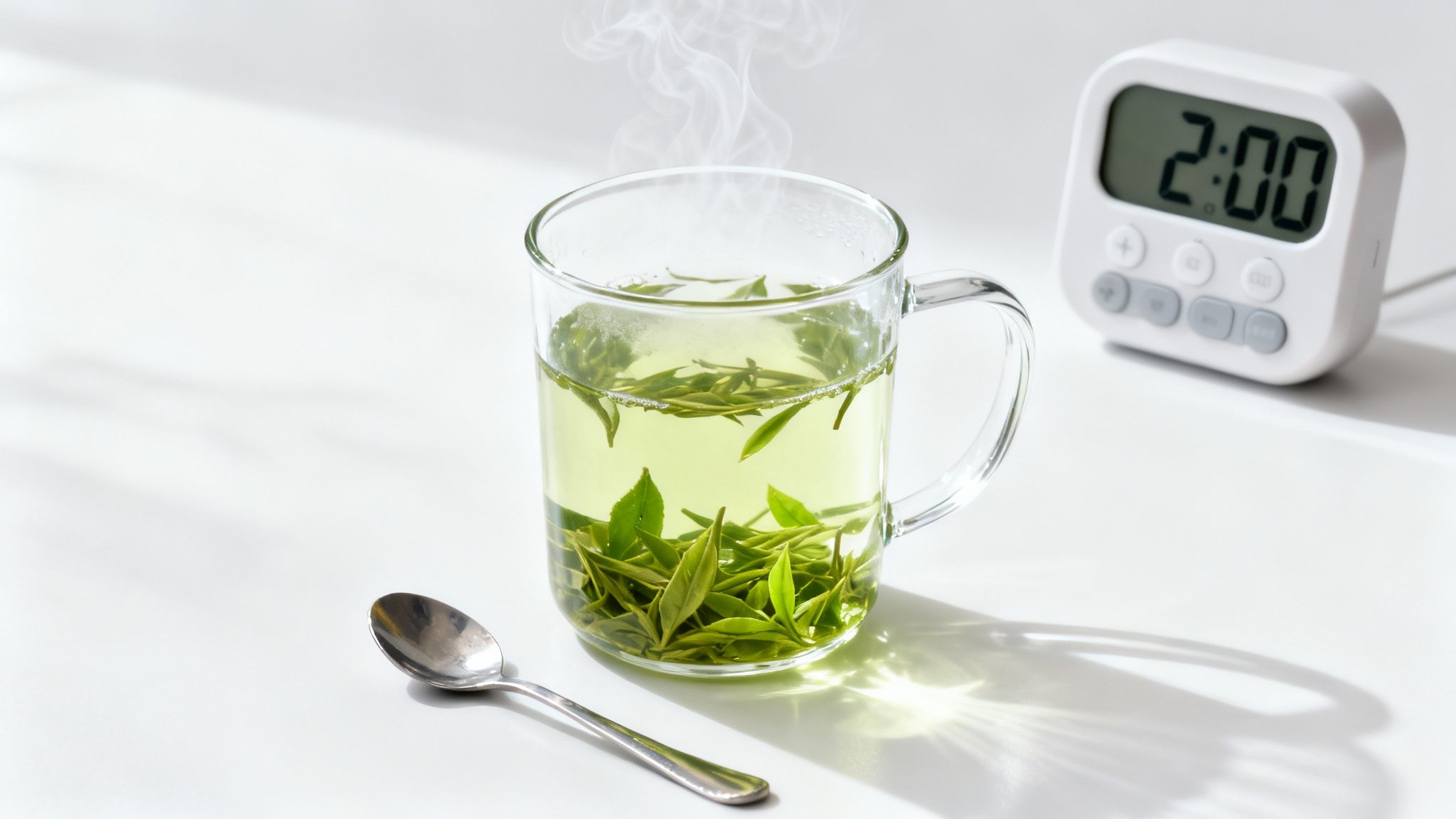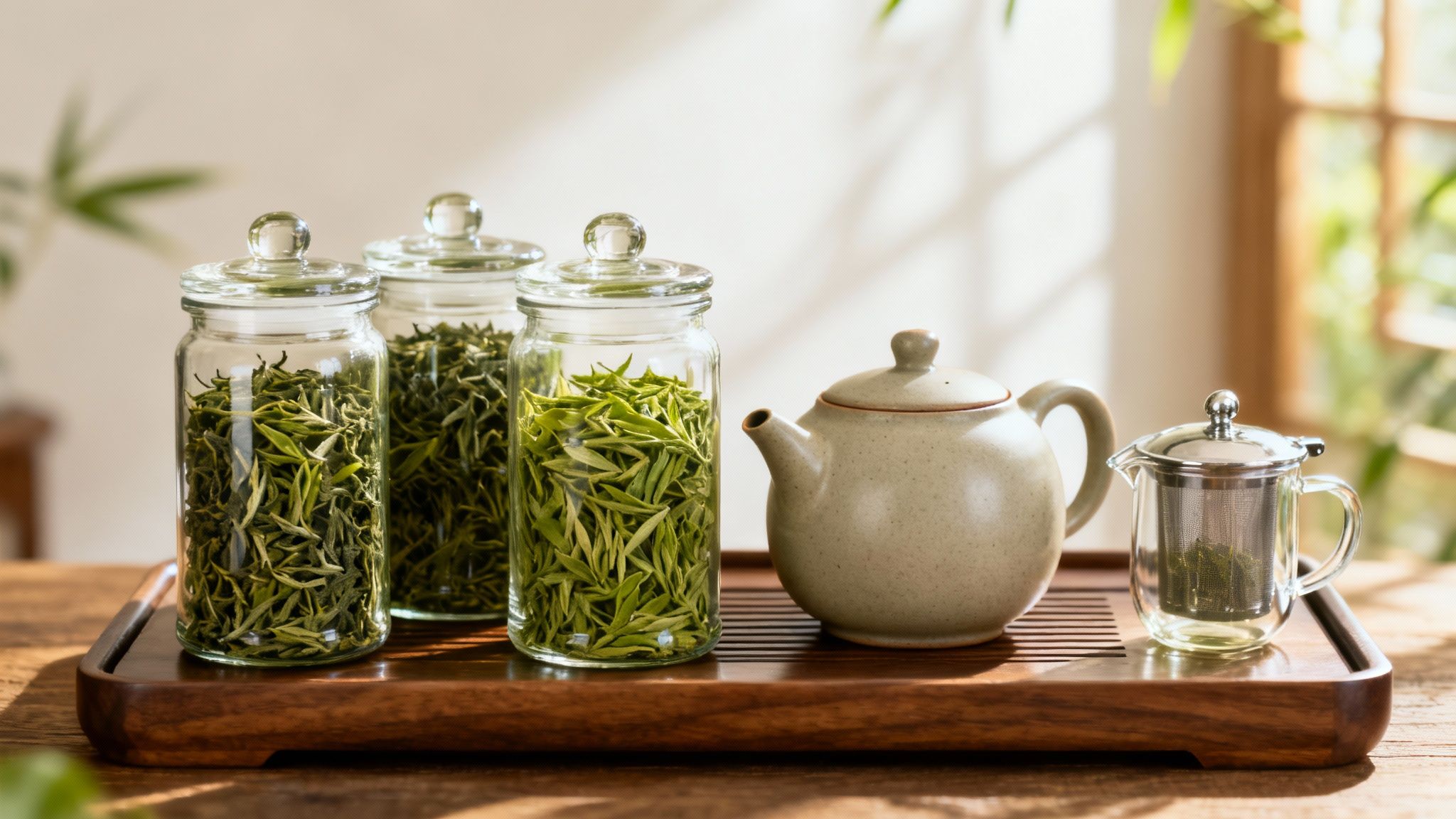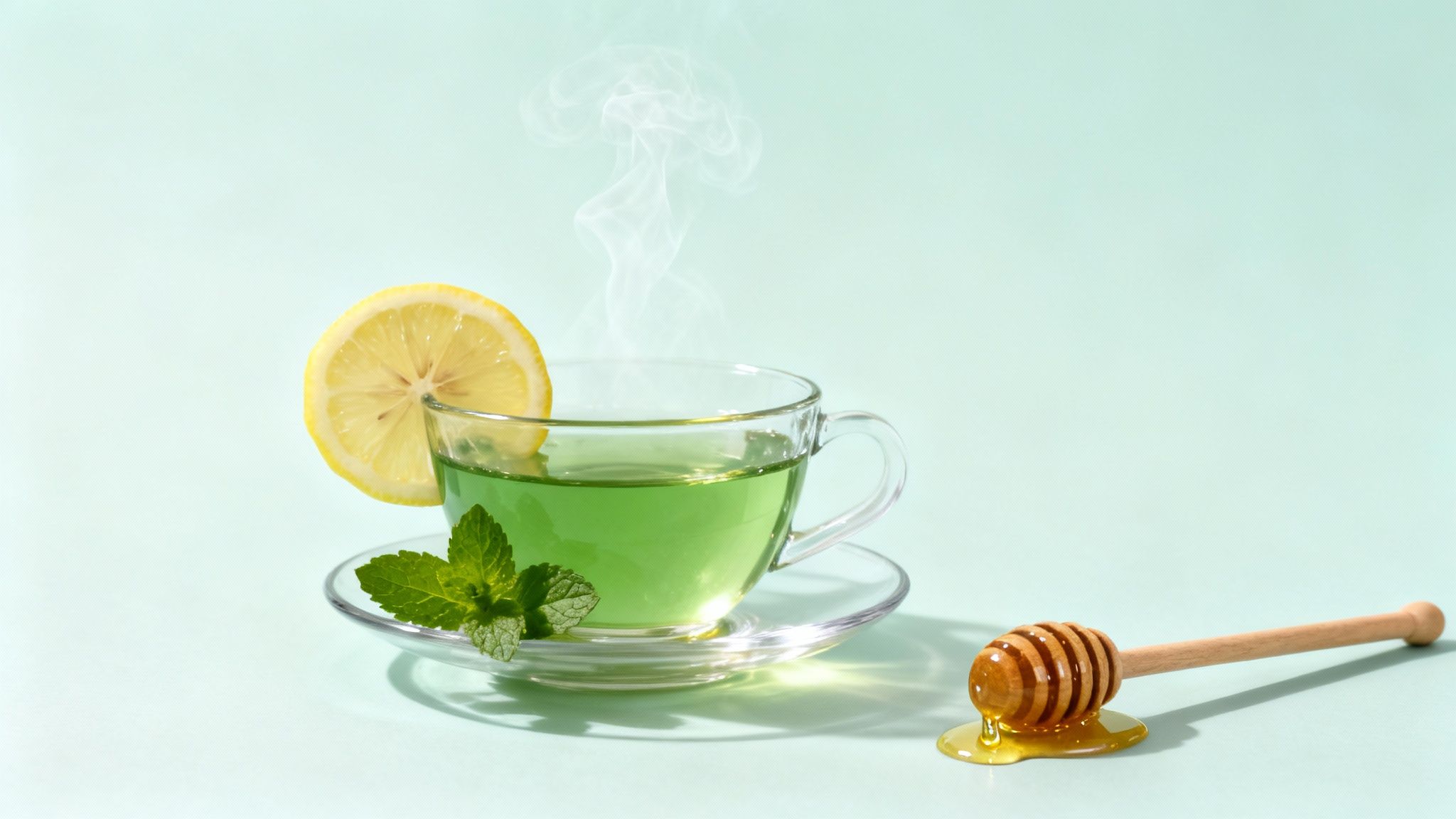Making a brilliant cup of green tea is far simpler than you might think. The big secret? Turn down the heat. Using cooler water (around 80°C) and a shorter brew time of just 2-3 minutes makes all the difference. This one change stops the delicate leaves from scalding and releasing bitter tannins, giving you a much smoother, sweeter cup.
Why Your Green Tea Tastes Bitter and How to Fix It
Let's be honest, that harsh, grassy flavour you sometimes get isn't what green tea is all about. If your brew is unpleasantly bitter, the culprit is almost always how you're making it. Unlike a robust black tea that can take boiling water, green tea leaves are much more delicate. When hit with water that’s too hot, they essentially get 'burnt'.
This scorching releases a flood of compounds called tannins. While tannins are a natural part of any tea, too many of them are responsible for that bitter, astringent taste. An over-extraction completely smothers the subtle, sweet, and even savoury notes that make a high-quality green tea so special.
Unlocking the True Flavour
Getting it right isn't about fancy gadgets; it’s about a little bit of know-how. By paying attention to a few simple things, you’ll notice a huge improvement in every single cup.
- Water Temperature: This is the most important change you can make. Let that boiled kettle sit for a few minutes before pouring.
- Steeping Time: Green tea infuses quickly. Anything more than a few minutes is usually too long.
- Leaf Quality: It goes without saying, but better leaves will always give you a more complex and flavourful brew.
These small tweaks are the first step to discovering why green tea is so loved. It's a trend that's really taking off, especially here in the UK. Research shows that 52% of Brits aged 25-34 drink green tea, which points to a real appetite for exploring different types of tea. You can read more about UK tea consumption trends from Mintel.
The secret to a perfect cup isn't about complex rituals, but about respecting the delicate nature of the leaves. A gentle approach with heat and time is all it takes to transform a bitter brew into a delightful experience.
Struggling to get it just right? Don't worry. Here’s a quick summary of common issues and the immediate adjustments you can make to improve the flavour of your green tea.
Quick Fixes for Common Green Tea Problems
| Problem | Common Cause | Immediate Solution |
|---|---|---|
| Overly Bitter or Astringent | Water is too hot, or you've steeped it for too long. | Let your kettle cool for 2-3 minutes before pouring. Steep for only 90 seconds on your next try. |
| Weak or Watery Flavour | Not using enough tea leaves for the amount of water. | Add more leaves. A good starting point is one teaspoon per 200ml of water, then adjust to your taste. |
| Dull or "Flat" Taste | The tea itself is old or of poor quality. | Check the expiry date on your tea. If it's old, it's time for a fresh batch. |
| Grassy or "Vegetal" Overload | This can be characteristic of some green teas, but steeping too long intensifies it. | Reduce your steeping time significantly, even down to 60 seconds, to find the sweet spot. |
Think of these as starting points. The perfect cup is subjective, so a little experimentation will help you find exactly what you enjoy.
Getting the Water Temperature Just Right

If there's one mistake I see people make over and over with green tea, it's pouring boiling water straight from the kettle onto the delicate leaves. It’s the fastest route to a bitter, astringent brew, and it’s a real shame.
That blast of 100°C heat essentially shocks and scalds the tea, forcing it to release an army of bitter-tasting tannins. Instead, what we're after is a much gentler persuasion. Lower temperature water coaxes out the good stuff—the sweet amino acids and those lovely, subtle savoury notes—leaving the harsh compounds behind. This single tweak is the secret to unlocking the true, complex flavour of a quality green tea.
Finding the Sweet Spot for Temperature
Now, not all green teas are created equal. Different styles appreciate slightly different temperatures, but you don't need a lab-grade thermometer to get it right. A good guideline will make a world of difference.
- Delicate Japanese Greens (like Sencha or Gyokuro): These are particularly sensitive. I find they sing at a cooler 70°C, which protects their refined, grassy notes.
- Heartier Chinese Greens (think Gunpowder or Dragon Well): These are a bit more robust and can handle more warmth. A temperature of around 80°C is a brilliant starting point.
Don't have a fancy variable-temperature kettle? Don't worry. Just boil the water as usual, then click the lid open and let it stand for two or three minutes. This is usually enough time to bring it down into that perfect green tea zone.
Another trick I often use is to simply pour a small splash of cold water into my mug first, just enough to cover the bottom. When you add the hot water, it instantly brings the overall temperature down, saving the leaves from that initial shock.
Nailing the water temperature is a massive step forward, but it's part of a bigger picture. For a more complete look at the process, our guide on how to brew loose leaf tea walks through everything from steeping times to the right teaware. In the end, a bit of experimentation will help you find the perfect temperature for your own palate.
Getting Your Steeping Time and Tea Ratio Spot On

Right, so you've got your water at the perfect temperature. What's next? Timing. This is where so many people go wrong.
It’s an easy mistake to make, but leaving your tea leaves in for too long is just as bad as scorching them with boiling water. Over-steeping pulls out too many tannins, which is what gives you that astringent, bitter taste that ruins an otherwise beautiful cup.
The ideal steeping time really depends on the type of green tea you're working with. Delicate Japanese teas might need just a quick dip, whereas many Chinese varieties can handle a little more time.
Finding That Sweet Spot
Nailing the infusion time is the difference between a good cup of green tea and a truly great one. From my experience, here are some reliable starting points:
- Japanese Greens (like Sencha or Gyokuro): These are the sensitive ones. I'd recommend a very short first steep of just 45-60 seconds.
- Chinese Greens (like Gunpowder or Dragon Well): These are a bit more forgiving. A good window to aim for is 2-3 minutes.
Don't be shy about using a timer—even a few seconds either way can completely alter the flavour. If you want to get really nerdy about it, we've got more tips on how long you are supposed to brew tea in our brewing guide.
One of the best things about good quality loose-leaf green tea is that you can steep it multiple times. The first brew might be bright and grassy, but the second can bring out sweeter, more mellow notes. Each infusion is a new discovery.
How Much Tea to Use?
The tea-to-water ratio is just as crucial as the timing. A solid rule of thumb to start with is one teaspoon of loose-leaf tea (that's about 2-3 grams) for every 200ml of water. Treat this as your baseline.
If the flavour is a bit weak for your taste, try adding a little more leaf next time instead of steeping it for longer. And if it's too strong? Just use a little less tea. It's a simple tweak that puts you in complete control of the final strength of your brew.
Picking Your Tea Leaves and Brewing Gear

The journey to a brilliant cup of green tea starts long before the kettle even thinks about boiling. The quality of your ingredients and tools makes all the difference to the final flavour. If you want to unlock the best possible taste, I always point people towards loose-leaf tea instead of standard tea bags.
Loose leaves bring a much richer and more complex flavour to the cup. It’s all down to the fact they're whole or large pieces of leaves, which hold onto more of their natural oils and aromatic compounds. On the other hand, the tea in many conventional bags is often just the smaller, broken bits—what we call "dust" and "fannings." This can lead to a brew that’s a bit flat and one-dimensional.
And if you're curious, there are many other different aspects of tea bags worth exploring beyond just their contents.
What to Look For in Your Tea
When you're choosing your leaves, trust your senses. A high-quality green tea should have a vibrant, uniform colour and a fresh, slightly sweet or grassy aroma. If it looks dull or smells a bit musty, chances are it's past its prime.
For a deeper dive into the different varieties and what makes each special, our guide on https://www.jeevesandjericho.com/blogs/news/what-is-the-best-green-tea is a great place to start.
Pro Tip: Don't feel you need to splash out on expensive kit. A simple mug with a basket infuser or a small ceramic teapot is genuinely all you need to get started on your path to a good tasting green tea.
Choosing Your Teaware
The material of your brewing pot or mug matters, too. Ceramic and glass are fantastic choices because they’re non-porous and won’t leach any unwanted flavours into your delicate tea.
While they're certainly convenient, some metal infusers can occasionally react with the tea, subtly altering its taste. A thoughtful choice in teaware goes a long way in preserving the pure, intended flavour of the leaves you've so carefully selected.
How to Customise Your Perfect Cup

Getting the basics right is one thing, but making a cup of green tea that's uniquely yours is where the real fun begins. Once you’ve got a handle on temperature and timing, you can start playing around to find what you truly love.
This naturally leads us to the hot topic of adding milk or sweeteners. While tea purists might be horrified, I’ve always believed the best cup of tea is the one you enjoy most.
The Great Milk Debate
Adding milk to green tea can be a bit divisive. While classic black tea is still the nation's favourite, with 70% of Brits drinking it, green tea is catching up. And it seems we’re putting our own spin on it – a surprising 35% of UK green tea drinkers now add a splash of milk. You can dive deeper into these trends in the full Tea Census study.
So, should you try it? If you're curious, my advice is to pick the right tea for the job. Delicate, grassy teas like Sencha get completely lost under the creaminess of milk. Instead, go for something with a toastier, more robust profile.
- Hojicha: This roasted Japanese green tea has lovely nutty, caramel-like notes that pair beautifully with milk. Think of it like a comforting latte.
- Genmaicha: The toasted rice in Genmaicha gives it a full-bodied, almost savoury flavour that holds its own against a bit of milk.
The rule is simple: there are no rules. Your palate is the only judge that matters. If you love a creamy Hojicha latte, then that’s the right way to drink it.
Sweeteners and Simple Additions
If you fancy a bit of sweetness, the trick is to complement the tea, not to smother it. A little drizzle of light honey or a touch of agave nectar can lift the tea’s natural notes without being overpowering. I’d personally steer clear of granulated sugar, as it can leave a slightly gritty texture.
You can also elevate your brew with a few fresh additions. A thin slice of lemon can brighten up the entire cup, while a sprig of fresh mint brings a wonderfully cool, aromatic dimension. Experimenting is the final, and most enjoyable, step in mastering your perfect green tea.
Your Green Tea FAQs, Answered
Even when you think you've got it all figured out, a few little questions can pop up. Getting these details right is often that last little step towards brewing a consistently beautiful cup of green tea. Let's get into some of the most common queries I hear.
One of the big ones is about storage. To keep your leaves at their best, you have to protect them from their four biggest enemies: air, light, heat, and moisture. An opaque, airtight container tucked away in a cool, dark cupboard is your best bet. Whatever you do, don't put your tea in the fridge or freezer – the condensation will absolutely wreck its delicate flavour.
Then there's the mystery of cloudy tea. If your brew looks a bit murky, it’s usually down to the natural compounds in the tea reacting with minerals in hard water. Switching to filtered water is a simple fix that often clears it right up, giving you a much cleaner-tasting cup.
Why Does My Tea Taste Different Each Time?
Ah, the consistency question. It’s a tricky one, but the answer usually lies in tiny variables you might be overlooking. Are you actually measuring your leaves, or just sort of guessing? Sticking to a consistent amount – say, one level teaspoon per cup – makes a world of difference.
Also, think about your water. The quality of tap water can change from day to day, and that will directly affect the flavour in your cup. If you notice your tea suddenly tastes off, trying filtered water is a brilliant first step in troubleshooting.
Remember, brewing green tea is a gentle art. The leaves need space to completely unfurl to release all their wonderful flavours. Try to avoid cramming them into a tiny infuser; giving them room to breathe and expand is key to unlocking their full aromatic potential.
And finally, can you re-steep green tea leaves? Absolutely! In fact, you should. High-quality loose leaves are made for multiple infusions. The first steep is often bright and grassy, but the second and third brews can reveal totally new notes – often deeper, sweeter, and more mellow. Don't just chuck them after one go, you're missing out on half the experience.


